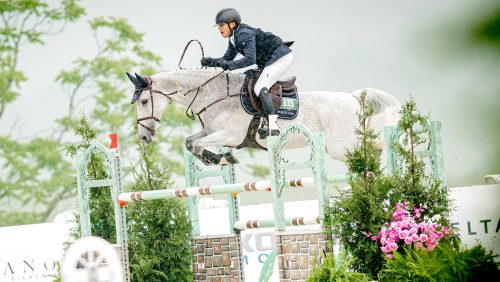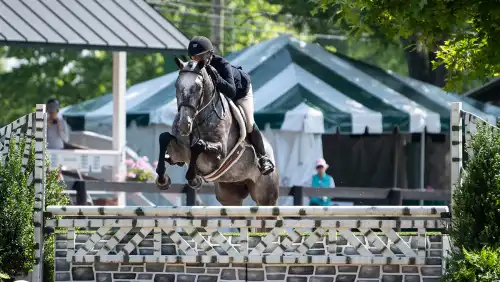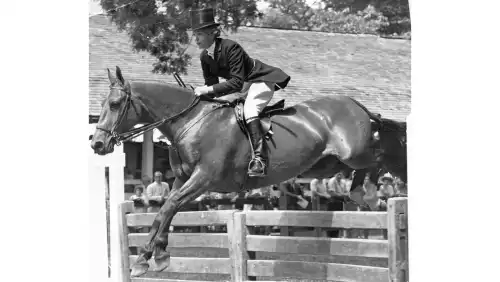A U.S. Equestrian Federation-generated protest measurement of two ponies at the Kentucky National Horse Show on Sept. 15 has reignited the debate surrounding pony hunter sizing.
Using a rule that’s been in the USEF Rule Book for years, a USEF steward selected two winning ponies—one medium and one large—on the last day of competition for a measurement check to ensure each was within his allowed height section. The ponies had an hour to prepare, and each pony measured into the correct section.
There’s long been a trend to exhibit “top-of-the-line” ponies, i.e. ponies at the very highest point of their height division, as these ponies will presumably have bigger strides to get down the lines more easily, not to mention fit a growing child for longer. Competitors may lodge a measurement protest against another pony in their division that they suspect is too tall through HU180, but in practice while talk of oversized ponies rules barn aisles, protests against them are rare.
Several rules, written by the U.S. Hunter Jumper Association’s Measurement Task Force and Pony Hunter Task Forces, were passed by the USEF at this year’s annual meeting, including one that’s been in place all year allowing for a one-time re-measurement of horses and ponies into a higher height section without penalty.
In other words, trainers who know they have an oversized pony in their barn have been able to request a one-time re-measurement from the USEF and exhibit the pony in the new, higher, height section. According to Mary Babick, vice president of the USHJA, head of the Hunter Working Group and a member of the Measurement Task Force, not a single pony has taken advantage of this rule, and that prompted the USEF to conduct what she referred to as a “spot check.”
“The Federation through Chrystine Tauber asked the USHJA to clean up the measurement situation, and one of the ways we did that was writing that rule,” said Babick. “We have the Federation reaching down and saying, ‘OK, you said this would help, and it’s not helping.’ ”
“A Groundswell Of Outrage“
USHJA president Bill Moroney sent out a letter explaining the protest and described the reaction ranging from anger to applause. Some disliked that the spot check was carried out after their last class on the second day of competition.
Babick pointed out that the task forces had discussed the best way to conduct such a re-measurement, as there’s no rule in the books explaining how to do it, and that they could have carried out the measurement as the ponies walked out of the ring after the jog. Sitting in an office, they theorized it would be least invasive to measure on Day 2, so trainers wouldn’t have to take off and tack on shoes, especially for older ponies with special shoes, or those with glue-on shoes. (HU 180.4 allows protested animals to be presented with our without shoes regardless of how they showed.) In practice, measuring ponies on a Sunday when barns are packing up to leave proved cumbersome.
ADVERTISEMENT
There’s a rule change proposal on the docket at this year’s USHJA Annual meeting clarifying how spot check shall be carried out going forward, but it doesn’t specify exactly when one may be carried out.
Download the rule change proposal here.
“There’s a huge groundswell of outrage among some that ponies and horses shouldn’t have to undergo a spot check, and then others are coming to me and saying, ‘Thank you, this is great,’ ” said Babick.
One Suggested Fix
The Pony Task Force has offered a new suggestion for consideration outlined in the USHJA letter: Take away pony height sections altogether and create sections based on fence height with restricted ages.
•Fences 2’3” open to riders up to age 12, lines set at 10’ strides
•Fences 2’6” open to riders up to age 14, lines set at 10’6” strides
•Fences 2’9” open to riders up to age 17, lines set at 11’ strides
This would allow a 11-year-old rider to ride a 14.1 hand pony over 2’3” fences if that was the appropriate division, or over 2’9″ fences if that was the appropriate division.
This is NOT yet an active rule change proposal, but a proposal submitted to USHJA members for comment at the upcoming annual meeting in December and at the next USHJA Town Hall Meeting on Thurs. Oct. 16 at the New England Equitation Finals in West Springfield, Mass., at 5 p.m.
If this rule change is presented and passed at the 2015 USHJA Annual Meeting, even if it were an extraordinary rule change, the soonest it would hit the books would be for the 2016 season, or, more likely, for the 2017 season should it pass as a standard rule change.
ADVERTISEMENT
Babick has personally been accepting feedback from members on the topic (ponycomments@ushja.org). Within two days of the letter going out she had received about 200 emails, as well as 50 emails to her personal account.
Based on what she’s heard so far, those at the top of the sport are for the new proposal, and the grassroots aren’t as keen.
“It’s interesting because I have access to all of this feedback, and the situation is about as clear as mud to me right now,” she said. “I do not have an opinion about this personally, but some people are rabidly for it, because they do have ponies that are too tall, and they see it as a way to get out of jail free. Others are rabidly against it because they see it as a license to cheat.
“We’re talking about a couple different topics,” she continued. “Are spot check measurements something that’s good? Is it a good idea to reorganize pony sections in this way?”
Other Ideas
Other USEF rules addressing measurement will kick in this Dec. 1, including increasing the age at which a pony may obtain a standard measurement card from 6 to 8, and toughening up penalties after an upheld protest. The Measurement Task Force spent the better part of last year filtering through suggestions and issues ranging from steward education; permanent identity; forms; measurement equipment and stations; owner, trainer and steward responsibility and protests.
Some have called for re-measurement of all ponies as the fairest solution, a suggestion rife with implementation problems.
“I’d say until we have more confidence in our measuring system, I don’t think that’s a good idea,” said Babick. “I have a customer who’s an engineer, and she and I are pursuing different modalities of measurement to see if we could come up with measurement that couldn’t be used incorrectly by someone who wasn’t good at measuring or had different ethics. I’m not against the idea in principle, but we have to sort that out.”
The current pony measurement conversations harken back to the infamous 1990 Washington International Horse Show (Md.) when the American Horse Shows Association re-measured all ponies that won ribbons. Trainers still tell stories of riders purposely trotting mid-course to avoid the stick, and the stress and tears as two of the 58 ponies measured didn’t make the cut. Several longtime changes came out of that debate, including improved steward education and a new standardized measuring stick.















